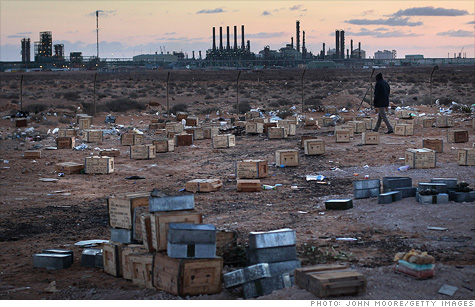
The country could double its crude output if international firms can return to revamp shuttered oil fields.
NEW YORK (CNNMoney) -- If a lasting peace manages to take hold in Libya, in just a few years the country's pre-war production of 1.6 million barrels a day of highly prized light oil could be flowing into the market.
For that to happen, it's likely a huge investment to rebuild the nation's decimated oil, transportation and social infrastructure will need to be made. That means millions, maybe billions, of dollars could be up for grabs for oil service companies like Halliburton (HAL, Fortune 500) and Schlumberger (SLB).
But the real prize lies below ground. The country has proven reserves of billions of barrels of untapped oil, the largest oil reserves in all of Africa. Some hope there's also billions more in undiscovered oil.
Thanks to years of underinvestment by the Gadhafi regime and international sanctions that kept many oil companies out, Libya hasn't developed its oil reserves so that they can produce to their full potential.
With the proper investment, some say Libya could go from a pre-war output of around 1.6 million barrels a day to 3 million barrels a day in ten years time.
"The oil is underground," said Ross Cassidy, a Libyan oil analyst at the energy research firm Wood Mackenzie. "It's a question of having the right conditions above ground that will allow investment."
The right conditions began to materialize in 2004, when Gadhafi gave up his nuclear weapons program and international sanctions were lifted against Libya.
In short order, dozens of agreements were signed with big European firms like BP (BP) and Shell (RDSA), along with smaller ones like Italy's Eni, France's Total (TOT) and Spain's Repsol. American companies like Occidental (OXY, Fortune 500), ConocoPhillips (COP, Fortune 500), Marathon (MRO, Fortune 500) and Hess (HES, Fortune 500) also got in on the act.
Marathon was the only company to immediately respond to a request for comment.
The company wouldn't say what it though of Libya's long term oil potential, but did say it had expected to produce 50,000 barrels a day in 2011 from Libya before the war started. When it might be able to reenter the country is unclear.
"To speculate on a timeframe for our return would be premature at this point," the company said in a statement. "We are planning as if there will be some damage to our facilities as well as normal issues associated with disuse."
Most of the agreements signed by the international oil companies called for increasing production from the country's existing oil fields, although some effort was put into finding new oil reserves.
That all stopped when war broke out last February.
While work on existing oil fields was progressing before the war started, the promise of vast new discoveries didn't pan out as well as some had hoped -- certainly not on the order of a country like Iraq, which is expected to triple or quadruple its oil output over the next couple of decades.
"Libya fell short of expectations," said Jim Burkhard, managing director of global oil supply at IHS Cambridge Energy Research Associates. "We didn't see the types of discoveries that would lead to very strong growth over the next decade."
Still, Burkhard said reaching three million barrels a day in 10 years "is in the realm of possibility."
But besides war, there are other obstacles to investing in Libya. Chief among them is the high royalty rate companies must pay to operate there.
Perhaps dispelling the notion in some circles that Western governments went to war in the country to "take Libya's oil," most of the contracts signed with the international oil companies stipulate that 90% of the proceeds generated from new oil production go straight to the national government.
That's not out of line with many other oil exporting countries, but it's much higher than the 50% or so oil companies pay in the United States. If Libya's royalty rate were lower, it's possible oil companies would invest more money there.
The contracts also contain strong provisions requiring the international oil firms to use lots of Libyan labor and materials, a process which could slow oil field development but greatly benefit the broader Libyan economy.
There's some disagreement among analysts if a new Libyan government will review those contracts, lowering the royalty rate or labor requirements in an attempt to entice more foreign investment.
'They weren't offering particularly attractive terms," said Burkhard. "They may reconsider those contracts to make it more attractive to invest."
But Wood Mackenzie's Cassidy says no.
"Every Libyan is fully aware of the importance of the oil sector and will ensure it is developed for the benefit of the Libyan people, just like the Iraqis are doing," he said. Iraq also has a royalty rate that can exceed 90%.
Whatever the outcome with the contracts, the most important thing currently stifling oil production is the ongoing violence in the country, and the damage that may have caused.
"Let's not forget, they have been at war for six months," said Burkhard. "This isn't over yet." ![]()
| Overnight Avg Rate | Latest | Change | Last Week |
|---|---|---|---|
| 30 yr fixed | 3.80% | 3.88% | |
| 15 yr fixed | 3.20% | 3.23% | |
| 5/1 ARM | 3.84% | 3.88% | |
| 30 yr refi | 3.82% | 3.93% | |
| 15 yr refi | 3.20% | 3.23% |
Today's featured rates: